![]()
![]()
![]()
Use LEFT and RIGHT arrow keys to navigate between flashcards;
Use UP and DOWN arrow keys to flip the card;
H to show hint;
A reads text to speech;
43 Cards in this Set
- Front
- Back
|
Quantity Supplied & Supply |
The quantity of real GDP supplied is the total quantity of goods and services, valued in constant base-year dollars, that firms plan to produce during a given period. |
|
|
Aggregate Supply |
The relationship between the quantity of real GDP supplied and he price level. |
|
|
Long Run Aggregate Supply |
Relationship et week quantity of real GDP supplied and the price level when the money wage rate changes in step with the price level to maintain full employment. |
|
|
Short Run Aggregate Supply |
Relationship between the quantity of real GDP supplied and the price level when the money wage rate, the prices of other resources as potential GDP remain constant. |
|
|
Long Run & Short Run Aggregate Supply |
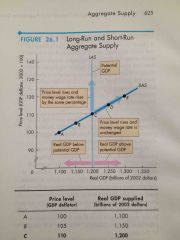
Back (Definition) |
|
|
Changes in Aggregate Supply |
A change in the price level changes the quantity of real GDP supplied. AS changes when an influence on production plans other than the price level changes. |
|
|
Changes in Potential GDP |
When potential GDP changes, aggregate supply changes. An increase in potential GDP increases long run & short run AS. -Increase in full employment quantity of labour -An increase in quantity of capital -An advance in technology |
|
|
Change in Potential GDP |

Back (Definition) |
|
|
Change in Money Wage Rate |
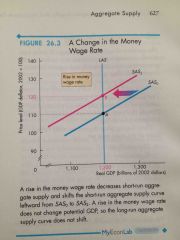
Back (Definition) When money wage rate (or money price of any other factor of production) changes, short run AS changes but long run AS does not. |
|
|
Aggregate Demand |
Quantity of real GDP demanded (Y) is the sum of real consumption expenditure (C), investment (I), government expenditure (G), and exports (X) minus imports (M). Y= C+I+G+X-M |
|
|
Buying Plans |
Depend on factors such as: -The price level -Expectations -Fiscal policy and monetary policy -The world economy |
|
|
Aggregate Demand |
Relationship between the quantity of real GDP demanded and the price level. Slopes downward because: -Wealth effect -Substitution effects |
|
|
Aggregate Demand |

Back (Definition) |
|
|
Wealth Effect |
When the price level rises, real wealth decreases. Real wealth is the amount f money in he bank, bonds, stocks and other assets people own, measure not in dollars but in terms of goods and services that the money, bonds, and stocks will buy. |
|
|
Substitution Effect |
When price level rises, interest rate rises. A rise in price level decreases the real value of money in people's pockets and bank accounts. |
|
|
Changes in Aggregate Demand |
A change in any factor that influences buying plans other than the price level brigs a change in AD. Main factors are: -Expectations -Fiscal policy and monetary policy -The world economy |
|
|
Fiscal Policy |
Government's attempts to influence the economy by setting and changing taxes, making transfer payments, and purchasing goods and services. |
|
|
Disposable Income |
Aggregate income minus taxes plus transfer payments. |
|
|
Monetary Policy |
The Bank Of Canada's attempt to influence the economy by changing interest rates and the quantity of money. |
|
|
Changes in Aggregate Demand |

|
|
|
Short Run Macroeconomic Equilibrium |
Occurs when the quantity of real GDP demanded equals the quantity of real GDP supplied. |
|
|
Long Run Macroeconomic Equilibrium |
Occurs when real GDP equals potential GDP-equivalently, when the economy is on its LAS curve. |
|
|
Economic Growth |
Results from a growing labour force and increasing labour productivity, which together make potential GDP grow. |
|
|
Economic Growth & Inflation |
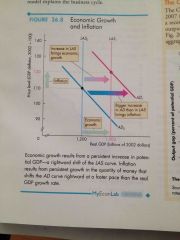
|
|
|
Above Full-Employment Equilibrium |
Equilibrium when real GDP exceeds potential GDP. |
|
|
Output Gap |
Gap between real GDP and potential GDP. |
|
|
Inflationary Gap |
When real GDP exceeds potential GDP, the output gap is called an inflationary gap. |
|
|
Full-Employment Equilibrium |
Real GDP equals potential GDP. |
|
|
Below Full-Employment Equilibrium |
An equilibrium in which potential GDP exceeds real GDP. |
|
|
Recessionary Gap |
When potential GDP exceeds real GDP, the output gap is called a recessionary gap. |
|
|
Above Full-Employment Equilibrium |

|
|
|
Full Employment Equilibrium |
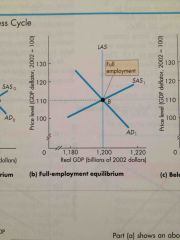
|
|
|
Below Full-Employment Equilibrium |
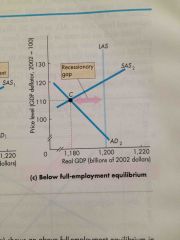
|
|
|
Fluctuations in real GDP |
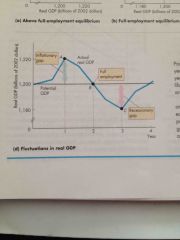
|
|
|
Increase in Aggregate Demand (Short Run) |
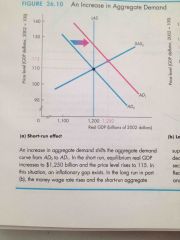
|
|
|
Increase in Aggregate Demand (Long Run) |
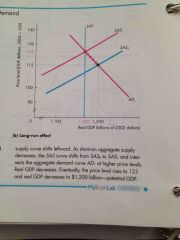
|
|
|
Decrease in Aggregate Supply |
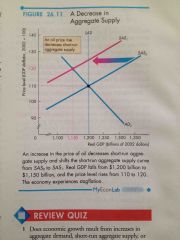
Graph
|
|
|
Stagflation |
A combination of recession and inflation. |
|
|
Classical View |
Believes the economy is self-regulating and always at full employment. |
|
|
New Classical View |
That business cycle fluctuations are the efficient repainted of a well-functioning market economy that is bombarded by shocks that arise from the uneven pace of technological change. |
|
|
Keynesian View |
Believes that left alone, the economy would rarely operate at full employment and that to achieve and maintain full employment, active help from fiscal policy and monetary policy is required. |
|
|
New Keynesian View |
Holds that not only the money wage rate is sticky, but also that prices of goods and services are sticky. |
|
|
Monetarist View |
Believes that the economy is self-regulating and that it will normally operate at full employment, provided that monetary policy is not erratic and that the pace of money growth is kept steady. |

